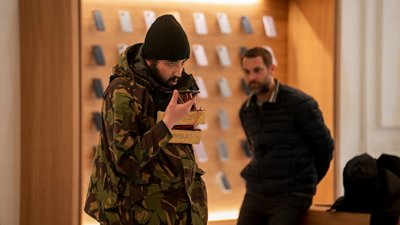The U.S. Patent and Trademark Office on Tuesday granted Apple a continuation of its hotly-contested "slide-to-unlock" patent, bringing further functionality to the invention that has already been used in the company's ongoing patent litigation.
At first blush, Apple's U.S. Patent No. 8,286,103 for "Unlocking a device by performing gestures on an unlock image" seems to be a rudimentary continuation of the '721 "Slide-to-unlock" property currently being leveraged against a number of Samsung handsets and tablets in a California court case. However, the newly-granted patent adds key language to the invention's claims regarding what is displayed on screen after the unlock gesture is performed.
For example, nowhere in the '721 patent's 15 claims is the word "application" mentioned, whereas Tuesday's continuation notes the term 8 times in 12 claims. Each time the '103 patent points out "application," it refers to the unlock gesture "transitioning the device to an application," such as the phone or mail apps.
Unlock gesture.Much of the filing's text is not changed, meaning the "transition to an application" terminology is not comprehensively fleshed out, save for the following, which was also included in the original '721 patent:
In some embodiments, the lock/unlock feature may apply to specific applications that are executing on the device as opposed to the device as a whole. In some embodiments, an unlock gesture transitions from one application to another, for example, from a telephone application to a music player or vice versa. The lock/unlock feature may include a hold or pause feature. In some embodiments, as the user transitions from a first application and to a second application, a user interface for the second application may fade in (i.e., increase in intensity) and a user interface for the first application may fade out (i.e., decrease in intensity). The fade in and fade out may occur smoothly over a pre-determined time interval, such as 0.2 s, 1 s or 2 s. The pre-determined time interval may be in accordance with the unlock gesture, such as the time it takes the user to perform the gesture.Multiple unlock images.
The slight change may not appear substantial, but with Apple's ongoing patent struggle, the "transition to application" verbiage may be powerful against certain iterations of devices running Google's Android operating system.
 Mikey Campbell
Mikey Campbell







-m.jpg)






 Christine McKee
Christine McKee
 Malcolm Owen
Malcolm Owen

 Charles Martin
Charles Martin


 Mike Wuerthele
Mike Wuerthele



-m.jpg)






2 Comments
Ummm, quite a few Android devices have had this functionality for years...
Ummm, quite a few Android devices have had this functionality for years...
Actually they haven't. At least not in the way that Apple was granted a patent that was deemed valid.
This particular patent has seen at least one major rewrite due to court cases. The original 'slide across the screen to unlock the device' was deemed too vague to be valid for patent protection. So Apple modified their patent to a very specific "slide across the screen using a preset gesture created as part of the base software for the device which may or may not be explained via words or an unlock image showing the location and/or direction of the gesture to be used". In other words, they patented their exact gesture, placement etc.
Most Android devices from the beginning have used a user created gesture that also acts as a passcode. Under the original version of the patent you are correct but under the new valid patent, nope.
Ironically, Apple as actually licensed the Android style gestures for at least one of their in house apps. I've seen it in use a couple of times during tech appointments. While it's too much for many folks, it would be nice if it was an option for those of us that use our devices for business.